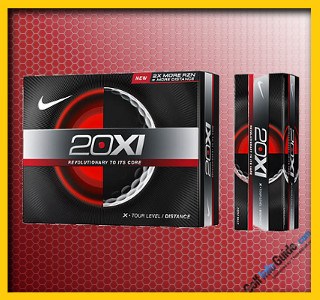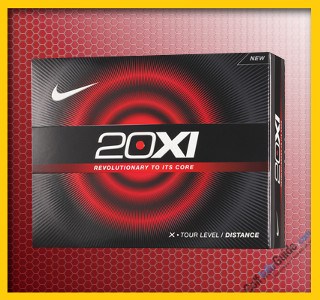
Ball tested: Nike 20XI
Category: Tour/Advanced/Performance
Specs: Construction – Four-piece; Cover – Urethane; Core – Resin; Dimples / Pattern – 360 in seamless design
Price as tested (new): $46 per dozen, but often available for less than $40
Ball notes: With Rory McIroy joining Tiger Woods on Team Nike in 2013, the company is firmly entrenched within the hierarchy of golf equipment brands. Still, Nike has historically struggled to produce a “tour” ball that earned widespread acclaim.
Compression: High
Its latest offering is the 20XI lineup, introduced in 2011 and tweaked in 2013. Nike touts the ball’s resin core and mantle (which it brands “RZN”), claiming the 20XI measures higher for MOI (Moment of Inertia) than any competitor models. While MOI isn’t often associated with golf balls, Nike says the optimized perimeter weighting reduces tee shot spin while stabilizing ball flight, making the 20XI especially effective in the wind.
For 2013, Nike gave the 20XI a larger, softer core to improve feel and distance. Golf Digest awarded the ball a gold medal in its Hot List rankings, while top pros including Paul Casey and Nick Watney put it in play.
The 20XI’s mate is the 20XI-X, a firmer ball designed to boost distance. If you’re wondering about the 20XI-S, it’s gone the way of balata balls – it’s been discontinued. However, the 20XI’s new formulation makes it a reasonable facsimile of that model.
As for Nike’s stud pros, McIlroy was among those playing the 20XI-X in 2013 while Woods was sticking with the One Tour D, which Nike no longer makes for the masses.

Sound and feel: Softer core equals softer feel. That’s our verdict on the revamped 20XI, which closely approximates the tour model standard set by the Titleist ProV1. This is most noticeable on short-game shots, though the difference is marked with the driver and irons, too.
Off the tee: Golfers who swing the driver at 100-plus mph should get plenty of carry and overall distance from the Nike 20XI. We did. It’s also maneuverable via fade or draw without being overly spinny. Perhaps best of all, this ball is very straight. You’ll have to make a pretty wild swing for the 20XI to get away from you. As Nike promised, it handles wind beautifully.
From the fairway / rough: The ball’s stable flight characteristics really shine with the irons. While it’s not the most workable tour ball, the 20XI is perfect for golfers who play little to no curve on their approach shots. Short irons landed with a nice hop-and-bite action.
Around the green: As we mentioned, Nike made major strides in this department with the 20XI. The original model’s clicky feel has been muted while performance is as good as if not better than before. Getting the 20XI to check on command is no problem, yet the ball is not so spin-happy that you’ll have issues when playing low runners.
Bottom line: We’re always a little skeptical about “new and improved” models, but Nike’s second-generation 20XI is an undeniably better ball than the original. Golfers who tried and disliked the first iteration would be wise to give the new version a try. We think you’ll be pleasantly surprised.
Golf Ball Videos:
– Compression Video
– Spin Video
– Dimples Video
– Golf Ball Brands Video
– Titleist Video
– Understanding Spin Video
Categories Explained:
Value/Recreational/Distance – Designed for mid- to high-handicap golfers with swing speeds below 90 mph; typically feature two-piece construction and firm covers; promote greater distance over high spin rates. Examples: Pinnacle Gold, Slazenger RAW Distance
Premium – Designed for low- to mid-handicap golfers with swing speeds of 90-99 mph; typically feature multi-layer construction and medium-soft covers; happy medium between Value/Recreational and Tour categories for distance and spin qualities. Examples: Titleist NXT Tour, Callaway HEX Diablo
Tour/Advanced/Performance – Designed for low-handicap and professional golfers with swing speeds in excess of 100 mph; typically feature multi-layer construction and soft covers; promote greater spin rates and enhanced feel over distance. Examples: Titleist ProV1, Bridgestone Tour B330





